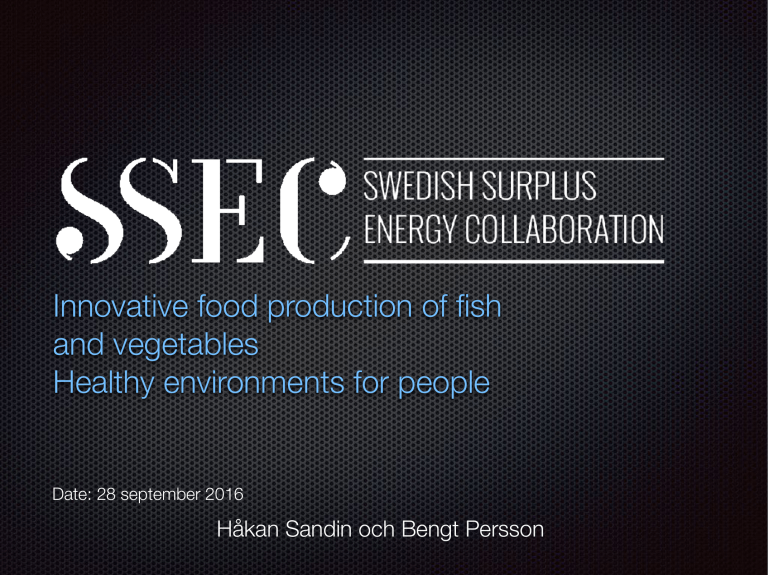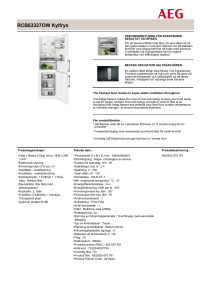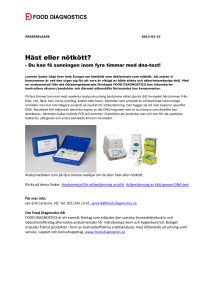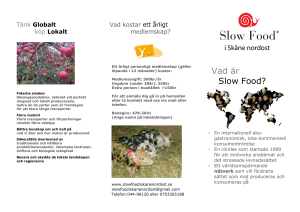
Innovative food production of fish
and vegetables
Healthy environments for people
Date: 28 september 2016
Håkan Sandin och Bengt Persson
Two main orientations within SSEC
Urban Food
Urban Health
Schematic illustration of the collaboration
September 2016
Mönsterås
Grönsaksmästarna
Nymölla
Bromölla
Växjö
ESS AB
Härnösands
kommun
Linné
universit
etet
Upplands Bro
Gävle Energi AB
Malmö stad
Syd Grönt
HIG
Veolia
Sveriges
ekokom
muner
SLU, Sveriges
Lantbruksuniversitet
Bjuvs kommun
Ljusdal
Svenska
Ramböll
Oskarshamns
kommun
Svenska EoN AB
Kraftringen
Energi AB
Facklan AB
KTH
Svenska
Findus AB
LIU
Oxelösund
Karlshamn
SBHUB
Upplands Bro
Strategic objectives
TWO LONG TERM STRATEGIC OBJECTIVES DESCRIBED FOR THE PROGRAM
Urban Food, A viable industry development
SSEC enables a new Swedish, intense, circular and symbiotic primary production
of fish and vegetables in urban and industrial environments.
Urban Health, Healthy human environments created
SSEC develops new healthy environments for people in urban areas.
Overall goal for SSEC
Construction commenced
of at least
three full-scale innovative facilities
during
2016 - 2018
I samarbete med sina partners
Results and effects of the SSEC
after 3 years from 2013 to 2015
redovisade den 17-18 september 2015
•
•
•
•
•
A solution for the recovery of low grade heat at ESS AB in Lund
Vega Fish Bjuv AB, production of giant shrimps
WA3RM, financiers, owners of new Greenhouse and fish production units
Royal Pride Sweden AB, Bjuv, tomato producer
Karlshamn MDHAP, a planning tool for municipalities to enable the establishment of fish and
vegetable production in the new industrial areas
• Pekka's Naturodlingar AB, closed aquaponic facilities in Härnösand.
• Ongoing planning of 50 hectares of tomato greenhouses in Bjuv, Gävle and Ljusdal.
• Over 10 sub-programs around the country of Sweden, Härnösand, Ljusdal, Gävle,
Oxelösund, Oskarshamn, Växjö, Mönsterås, Karlshamn, Bromölla, Bjuv, Lund, Malmö, etc.
• A large number of projects to support the development.
•
•
Energy and resource-effective greenhouse technology competitive in an international market.
Recirculation based production and processing of vegetables and fish
6
Results and effects of the
SSEC 2015 - 2016
The initial public offering of the aquaponic
company Peckas Naturodlingar från Härnösand is
made during September.
Two full-scale innovative facilities
in Bjuv and Gävle respectively are being planned.
I samarbete med sina partners
Insight # 1
There is a large and growing market for fish and
vegetables both in Sweden and abroad
Reduced energy costs during the regular growing season and the opportunity to extend the
growing season into the winter months are contributing to increased competitiveness of
production with residual heat.
The competitiveness of new cultures can be further strengthened by focusing on niche
market segments, such as organic farming and the cultivation of special varieties. This
approach, however, has no connection to the residual heat is used.
Price premium for the "Swedish" can be strengthened through joint marketing in the
industry that highlights Swedish added value.
Land-based production of fish / seafood and greenhouse production of excess heat as an energy source
8
Sales of food in Sweden In miljon SEK (2010)
•
•
•
•
Bread and cereal products
Meat and fish
Milk and dairy products
Fruits and Vegetables
31114
28617
30724
44252
Håkan Sandin
Den svenska fisk och skaldjursmarknaden växer kraftigt men
gös och abborre står för en liten andel av fiskkonsumtionen
Svenskar konsumerar mer fisk och skaldjur(MDR KR)1
Svenskt vattenbruk och insjöfiske är idag mycket litet jämfört med havsfisket (ton)
Fångsterna av Gös och Abborre är för-
hållandevis små och utgör ~35% av fångsten från Sveriges insjöar (% av fångst, ton)2
171 969
Övriga
Ål 6,3
2,6
4,0
4,6
11 152
Gädda
29%
(401)
6%
(83)
Kräfta
2000
2005
2010
2014
Havsfiske2 Vattenbruk3 Insjöfiske2
Gös
Abborre
Siköja
• Svenskar äter ca 16 kg fisk per år • Merparten av den landade fisken i jämfört med 85 kg kött.
Sverige säljs via Göteborgs fiskauktion.
• Lax och torsk står för merparten av • Vattenbruket i havs- och sjöbaserade kassar svenskars fiskkonsumtion.
består främst av Regnbåge (9 436 ton) • De viktigaste egenskaperna när och Röding (1 644 ton).
konsumenter köper fisk är kvalitet och pris.
1SCB:
Försäljning (inkl. moms) av livsmedel och drycker inom handeln (enligt COICOP), löpande priser, mnkr efter varugrupp och år
Det yrkesmässiga fisket i Sverige
3Jordbruksverket: Svenskt Vattenbuksproduktion
2SCB:
10
Den svenska konsumtionen av grönsaker, inklusive
konsumtionen av tomat och gurka, växer
Svenskar konsumerar mer grönsaker och potatis (MDR KR)1
Konsumtionen per capita av tomater
och gurka ökar2 (kg per capita)
13,5
9,2
10,5
11,9
38,8
Tomater
8,6
Gurka
4,3
41,9
10,0
4,4
44,5
9,8
5,6
47,0
10,4
6,2
Lök
Tomat
Svensk produktion
Import
Export
Svensk konsumtion
Purjolök
Sallad
Övr. köksväxter
2005
2010
2014
15
93
1
110
Gurka
Broccoli & kål
2000
Produktion, import, export och konsumtion
för analyserade grönsaker (-000 ton) 2
2000
2005
2010
2014
28
33
Svensk produktion
Import
Export
Svensk konsumtion
0
61
Paprika
Svensk produktion
Import
Export
Svensk konsumtion
1SCB:
Försäljning (inkl. moms) av livsmedel och drycker inom handeln (enligt COICOP), löpande priser, mdr kr efter varugrupp och år
– Marknadsöversikt 2014 Färska frukter och grönsaker
2Jordbruksverket
29
29
11
I samarbete med sina partners
Insight # 2
Circular horticultural and land-based aquatic industry
is very beneficial for the Swedish society
•
•
•
•
•
•
•
Creates employment for may people in new businesses
Produces healthy and safe food
Recycles residual flows in society
Streamlines existing industry
Uses oversized infrastructure
Creates great environmental values
Develops new land-based food production systems in industrial and periurban environments with an international impact
• Enables export
12
I samarbete med sina partners
Insight # 3
We can create a lot of employment in small areas and
increase productivity significantly, in the agricultural
sector, by thinking more fish and vegetables.
Primary production
potatoes, fruit, vegetables, nursery and
ornamental plants. 1 job in the primary
production relates to 10 job in the over all
value chain.
50 000 ha in Sweden
8000 full-time jobs in Sweden
70-80 percent in Scania.
7 billion value in Sweden
5 billion value in Skåne
140 000 per hectare.
13
50 hektar tomatodling och 5000 ton fisk, akvaponik,
skapar 500 nya jobb
I samarbete med sina partners
Insight # 4
Future food entrepreneurs have not easily access to land or
capital
• is often a person who has no background in the food industry
• do not have access to knowledge about the possibilities of becoming a food
entrepreneur
15
I samarbete med sina partners
Insight # 5
Residual Flows of various kinds is a resource for
innovative development of urban food production and
urban healthy environments
With the help of residual flows from the town of for example low-grade heat, quality-separated
food waste or carbon dioxide, we can build a whole new town near circular food production of
primary products such as fish and vegetables.
By also utilizing the infrastructure available in the city, we create a better economy for both the
food industry, the city and the infrastructure owners such as district heating systems.
Through the use of district heating infrastructure in our cities, we can create innovative healthy
environments for people.
16
SURPLUS HEAT FOR HEALTH
We use surplus heat and other residual flows from our cities and industry to create a healthier environment
for both people and the growth of fish and vegetables
Insight # 6
Logistically and industrially
smart located production of
fish and vegetables in Sweden
The new large, insight / innovation this year,
2016 is the understanding that we can grow
together with industrial property and logistics
companies.
Therefore, we have made contact with Catena
and together with them try to develop a
business idea.
We also suggest that they should be one of our
partners, in order for us to grow together with
over Sweden.

















